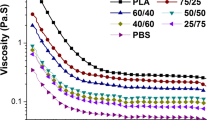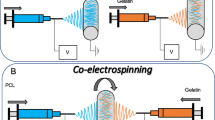Abstract
In this study, microfiber films were used as scaffolds for the purpose of vascular tissue engineering. The microfiber films were prepared by electrospinning of poly (l-lactide) (PLLA) and polyvinyl pyrrolidone (PVP). PLLA and PVP with different ratios were blended with dichloromethane as a spinning solvent at room temperature. The properties of the composite microfiber films were investigated by differential scanning calorimetry (DSC), scanning electron microscopy (SEM) and contact angle measurement. The SEM images showed that the morphology of the microfiber films was mainly affected by the weight ratios of PLLA/PVP. The DSC results demonstrated that PLLA and PVP mixed uniformly. And the hydrophilicity of the films measured increased along with the decrease of the PLLA/PVP ratio. Vascular smooth muscle cells (VSMCs) were used to test the cytocompatibility. Cell morphology and cell proliferation were measured by SEM, laser scanning confocal microscopy (LSCM) and MTT (3-(4,5-dimethylthiazol-2-yl)-2,5-diphenyl tetrazolium bromide) assay after 2, 4, 6 days of culture. The results indicated that the cell morphology and proliferation on the composite films were better than that on the pure PLLA film. Furthermore, morphology and proliferation of VSMCs became better with decreasing of the weight ratio of PLLA/PVP. In addition, adhesion of platelet on the films was observed by SEM. The SEM images showed that the number of adhered platelets decreased with increment of PVP content in the films. The electrospinning microfiber composite films of PLLA and PVP would have potential use as the scaffolds for vascular tissue engineering.






Similar content being viewed by others
References
V.L. Tsang, S.N. Bhatia, Fabrication of three-dimensional tissues. Adv. Biochem. Eng. Biotechnol. 103, 189 (2007)
K.D. Andrews, J.A. Hunt, R.A. Black, Technology of electrostatic spinning for the production of polyurethane tissue engineering scaffolds. Polym. Int. 57, 203 (2008). doi:10.1002/pi.2317
W.S. Li, Y. Guo, H. Wang, D.J. Shi, C.F. Liang, Z.P. Ye, F. Qing, J. Gong, Electrospun nanofibers immobilized with collagen for neural stem cells culture. J. Mater. Sci.: Mater. Med. 19, 847 (2008). doi:10.1007/s10856-007-3087-5
A. Martins, J.V. Araujo, R.L. Reis, N.M. Neves, Electrospun nanostructured scaffolds for tissue engineering applications. Nanomedicine 2, 929 (2007). doi:10.2217/17435889.2.6.929
O. Ayodeji, E. Graham, D. Kniss, J. Lannutti, D. Tomasko, Carbon dioxide impregnation of electrospun polycaprolactone fibers. J. Supercrit. Fluid. 41, 173 (2007). doi:10.1016/j.supflu.2006.09.011
F. Chen, C.N. Lee, S.H. Teoh, Nanofibrous modification on ultra-thin poly(epsilon-caprolactone) membrane via electrospinning. Mater. Sci. Eng. C 27(2), 325 (2007). doi:10.1016/j.msec.2006.05.004
J.B. Chiu, C. Liu, B.S. Hsiao, B. Chu, M. Hadjiargyrou, Functionalization of poly(L-lactide) nanofibrous scaffolds with bioactive collagen molecules. J. Biomed. Mater. Res. A 83A, 1117 (2007). doi:10.1002/jbm.a.31279
J.S. Choi, H.S. Yoo, Electrospun nanofibers surface-modified with fluorescent proteins. J. Bioact. Compat. Polym. 22, 508 (2007). doi:10.1177/0883911507081101
Y.B. Zhu, M.F. Leong, W.F. Ong, M.B. Chan-Park, K.S. Chian, Esophageal epithelium regeneration on fibronectin grafted poly(L-lactide-co-caprolactone) (PLLC) nanofiber scaffold. Biomaterials 28, 861 (2007). doi:10.1016/j.biomaterials.2006.09.051
P.C. Zhao, H.L. Jiang, H. Pan, K.J. Zhu, W. Chen, Biodegradable fibrous scaffolds composed of gelatin coated poly(epsilon-caprolactone) prepared by coaxial electrospinning. J. Biomed. Mater. Res. A 83A, 372 (2007). doi:10.1002/jbm.a.31242
H.W. Tong, M. Wang, Electrospinning of aligned biodegradable polymer fibers and composite fibers for tissue engineering applications. J. Nanosci. Nanotechnol. 7, 3834 (2007). doi:10.1166/jnn.2007.051
M. Spasova, O. Stoilova, N. Manolova, I. Rashkov, G. Altankov, Preparation of PLIA/PEG nanofibers by electrospinning and potential applications. J. Bioact. Compat. Polym. 22, 62 (2007). doi:10.1177/0883911506073570
F. Yang, X. Qu, W.J. Cui, J.Z. Bei, F.Y. Yu, S.B. Lu, S.G. Wang, Manufacturing and morphology structure of polylactide-type microtubules orientation-structured scaffolds. Biomaterials 27, 4923 (2006). doi:10.1016/j.biomaterials.2006.05.028
C.T. Lee, C.P. Huang, Y.D. Lee, Biomimetic porous scaffolds made from poly(L-lactide)-g-chondroitin sulfate blend with poly(L-lactide) for cartilage tissue engineering. Biomacromolecules 7, 2200 (2006). doi:10.1021/bm060451x
M.V. Risbud, S.V. Bhat, Properties of polyvinyl pyrrolidone/beta-chitosan hydrogel membranes and their biocompatibility evaluation by haemorheological method. J. Mater. Sci.: Mater. Med. 12, 75 (2001). doi:10.1023/A:1026769422026
A. Benahmed, M. Ranger, J.C. Leroux, Novel polymeric micelles based on the amphiphilic diblock copolymer poly(N-vinyl-2-pyrrolidone)-block-poly(D, L-lactide). Pharm. Res. 18, 323 (2001). doi:10.1023/A:1011054930439
S.J. Lee, J.J. Yoo, G.J. Lim, A. Atala, J. Stitze, In vitro evaluation of electrospun nanofiber scaffolds for vascular graft application. J. Biomed. Mater. Res. A 83A, 999 (2007). doi:10.1002/jbm.a.31287
P.D. Dalton, D. Grafahrend, K. Klinkhammer, D. Klee, M. Moller, Electrospinning of polymer melts: phenomenological observations. Polymer (Guildf) 48, 6823 (2007). doi:10.1016/j.polymer.2007.09.037
R. Chen, J.A. Hunt, Biomimetic materials processing for tissue-engineering processes. J. Mater. Chem. 17, 3974 (2007). doi:10.1039/b706765h
M. Peesan, R. Rujiravanit, P. Supaphol, Electrospinning of hexanoyl chitosan/polylactide blends. J. Biomater. Sci. Polym. Ed. 17, 547 (2006). doi:10.1163/156856206776986251
Y.T. Jia, J. Gong, X.H. Gu, H.Y. Kim, J. Dong, X.Y. Shen, Fabrication and characterization of poly (vinyl alcohol)/chitosan blend nanofibers produced by electrospinning method. Carbohydr. Polym. 67, 403 (2007). doi:10.1016/j.carbpol.2006.06.010
X.M. Mo, C.Y. Xu, M. Kotaki, S. Ramakrishna, P. Electrospun, LLA-CL) nanofiber: a biomimetic extracellular matrix for smooth muscle cell and endothelial cell proliferation. Biomaterials 25, 1883 (2004). doi:10.1016/j.biomaterials.2003.08.042
A. Welle, M. Kroger, M. Doring, K. Niederer, E. Pindel, S. Chronakis, Electrospun aliphatic polycarbonates as tailored tissue scaffold materials. Biomaterials 28, 2211 (2007). doi:10.1016/j.biomaterials.2007.01.024
S. Borhani, S.A. Hosseini, S.G. Etemad, J. Militky, Structural characteristics and selected properties of polyacrylonitrile nanofiber mats. J. Appl. Polym. Sci. 108(5), 2994 (2008). doi:10.1002/app.27904
Y. Xin, Z.H. Huang, J.F. Chen, C. Wang, Y.B. Tong, S.D. Liu, Fabrication of well-aligned PPV/PVP nanofibers by electrospinning. Mater. Lett. 62, 991 (2008). doi:10.1016/j.matlet.2007.07.031
O. Mert, E. Doganci, H.Y. Erbil, A.S. Dernir, Surface characterization of poly(L-lactic acid)-methoxy poly(ethylene glycol) diblock copolymers by static and dynamic contact angle measurements, FTIR, and ATR-FTIR. Langmuir 24, 749 (2008). doi:10.1021/la701966d
Y.Z. Wu, Y. Hu, J.Y. Cai, S.Y. Ma, X.P. Wang, Coagulation property of hyaluronic acid-collagen/chitosan complex film. J. Mater. Sci.: Mater. Med. 19, 3621 (2008). doi:10.1007/s10856-008-3477-3
Acknowledgment
This work was in part supported by National Natural Science Foundation of China (50573044 & 50830102) and National Basic Research Program (2005CB623905).
Author information
Authors and Affiliations
Corresponding author
Rights and permissions
About this article
Cite this article
Xu, F., Cui, FZ., Jiao, YP. et al. Improvement of cytocompatibility of electrospinning PLLA microfibers by blending PVP. J Mater Sci: Mater Med 20, 1331–1338 (2009). https://doi.org/10.1007/s10856-008-3686-9
Received:
Accepted:
Published:
Issue Date:
DOI: https://doi.org/10.1007/s10856-008-3686-9




